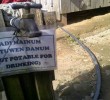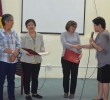SUBIC BAY FREEPORT�A 36-man economic delegation from Guangxi Zhuang Autonomous Region, People�s Republic of China (PROC) visited here as part of its apparent gesture of strengthening mutual cooperation and friendship between the PROC and the Republic of the Philippines.
Subic Bay Metropolitan Authority (SBMA) Chairman Feliciano G. Salonga welcomed the delegation led by Secretary Liu Qibao of Communist Party of China (CPC)-Guangxi Committee, and currently Chairman of Standing Committee of Guangxi People�s Congress.
Salonga, who gave the delegates a briefing on the present tourism and industrial developments in the Subic Freeport said, �The Subic Freeport today is now pushing towards achieving its goal of becoming a tourist haven and, at the same time, a maritime hub.�
Salonga noted that because of the influx of investors to the Subic Bay Freeport, a third industrial park with a land space of 100 hectares is set to be developed near the Gateway Area beside the Subic-Clark-Tarlac Expressway Toll Plaza; and another vast forest area will also be converted into an eco-tourism park.
Among the members of the Liu�s party were CPC Guangxi Committee Deputy Director-General Su Haitang, Department of Finance Director-General Su Daoyan, Foreign Affairs Office Director-General Huang Yongqiang, China-ASEAN Expo Secretariat Secretary-General Zhang Xiaoqin, Agricultural Department Director-General Zhang Mingpei, and State Farms Bureau Director-General Liu Zhiyong.
Liu disclosed that their visit was aimed at promoting cooperation between Guangxi and Subic Bay, as well as seek the possibility of creating a sisterhood pact between the two port areas.
�Primarily, our objective is to promote cooperation, like what we intend to do in other countries around South China Sea,� said Sec. Liu.
According to Liu, Guangxi�s important crops include rice, maize, sweet potatoes, and wheat, while cash crops include sugar cane, peanuts, tobacco, and kenaf. It has also more tin, manganese, and indium deposits than any other province in China.
�The Subic Port is one of the major and most important ports in Southeast Asia, with very tolerable clearances of water depth, and infrastructures express impressive developments. There Subic Freeport has a great potential to become competitive in international shipping industry,� he said.
He added that Guangxi relies heavily on ports for low transportation cost to bring its produce in the world market, and Subic is an ideal place to put up a transshipment hub for their crops and other products, including heavy equipment and farm machines.
Liu also revealed Guangxi�s plan to promote tourism in the area by promoting its passenger airliners across South China Sea. He also invited Salonga to visit Guangxi’s Nanning City in October for the third China-ASEAN (Association of Southeast Asian Nations) Expo where Chinese leaders and leaders of the ten ASEAN members will participate.
Meanwhile, Salonga expressed his gratitude to the visiting delegates saying that the idea to make Subic Port as distribution hub for goods, especially cassava, from Guangxi, will not only ensure the steady supply of farm goods but will also help in the promotion of bio-diesel in the country which the Philippine government is currently promoting. (30)










